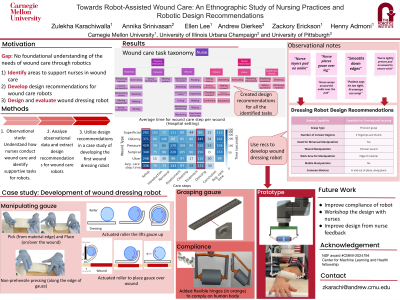Evidence-Based Practice
(EBP-010) Towards Robot-assisted Wound Care: An Ethnographic Study of Nursing Practices and Robotic Design Reccomendations
Friday, May 2, 2025
7:45 PM - 8:45 PM East Coast USA Time

Annika Srinivasan, Undergraduate – Undergraduate researcher, Mechanical engineering, University of Illinois Urbana-Champaign; Ellen Lee, Undergraduate – Undergraduate researcher, Mechanical Engineering, Carnegie Mellon; Andrew Dierkes, Assistant Professor – Assistant Professor, School of Nursing, University of Pittsburgh; Zackory Erickson, Assistant Professor – Assistant Professor, Robotics Institute, Carnegie Mellon; Henny Admoni, Associate Professor – Associate Professor, Robotics Institute, Carnegie Mellon University
Introduction: Chronic wounds impact nearly 8 million people in the United States, costing approximately $21.4 billion annually. These wounds place considerable demand on the healthcare system, already burdened by severe nursing shortages. Robotics can provide assistance and help meet wound care demand, reduce nurses' time spent on wound care, lower their physical task load, deliver time-sensitive solutions, and remain cost-efficient. However, research in nursing robotics for wound care is limited. Typically, healthcare stakeholders’ input is only used as an evaluation metric after robotic systems have been developed. Research in nursing robotics for wound care remains nascent, and there is a need to involve nurses as key stakeholders early in the design process to ensure that robotic solutions align with the practical needs of wound care before technologies are developed.
Methods: We approached this challenge through a nursing-centered ethnographic study. We observed nurses performing wound care, and documented the process to understand wound care and potential opportunities for robotic assistance. We collected data by observing care for 86 wounds in two locations: a hospital and an assisted living facility. Through a robotics framework, we used thematic analysis to code our observations, and created a taxonomy of wound care interactions associated with wound care tasks. Through this analysis, we also provided design recommendations for developing robot-assisted wound care solutions that aim to support healthcare professionals and improve patient outcomes.
Results: We found wound dressing was the most common and time-consuming care task. Based on these results, we implemented our design recommendations to develop a specialized wound dressing robotic system. This system can perform key wound dressing steps: picking up a gauze pad, placing it over a wound, and securing it by pressing adhesive tape along each edge of the gauze.
Discussion: Our study led to the creation of a taxonomy that describes nurse interaction and wound care tasks. Our iterative process further informed design recommendations for these tasks, and a prototype of a wound dressing robot.This is the first study that seeks to understand how nurses conduct wound care under a robotics framework, and also provides the first design recommendations for various wound care task robotic systems. The collaboration of key stakeholders was integral in translating assistive robotic frameworks into a viable prototype. This approach helps bridge the gap between the current state of wound care and the potential benefits of using robotics to improve the efficiency, effectiveness, and standardization of the process.
Methods: We approached this challenge through a nursing-centered ethnographic study. We observed nurses performing wound care, and documented the process to understand wound care and potential opportunities for robotic assistance. We collected data by observing care for 86 wounds in two locations: a hospital and an assisted living facility. Through a robotics framework, we used thematic analysis to code our observations, and created a taxonomy of wound care interactions associated with wound care tasks. Through this analysis, we also provided design recommendations for developing robot-assisted wound care solutions that aim to support healthcare professionals and improve patient outcomes.
Results: We found wound dressing was the most common and time-consuming care task. Based on these results, we implemented our design recommendations to develop a specialized wound dressing robotic system. This system can perform key wound dressing steps: picking up a gauze pad, placing it over a wound, and securing it by pressing adhesive tape along each edge of the gauze.
Discussion: Our study led to the creation of a taxonomy that describes nurse interaction and wound care tasks. Our iterative process further informed design recommendations for these tasks, and a prototype of a wound dressing robot.This is the first study that seeks to understand how nurses conduct wound care under a robotics framework, and also provides the first design recommendations for various wound care task robotic systems. The collaboration of key stakeholders was integral in translating assistive robotic frameworks into a viable prototype. This approach helps bridge the gap between the current state of wound care and the potential benefits of using robotics to improve the efficiency, effectiveness, and standardization of the process.

.jpg)